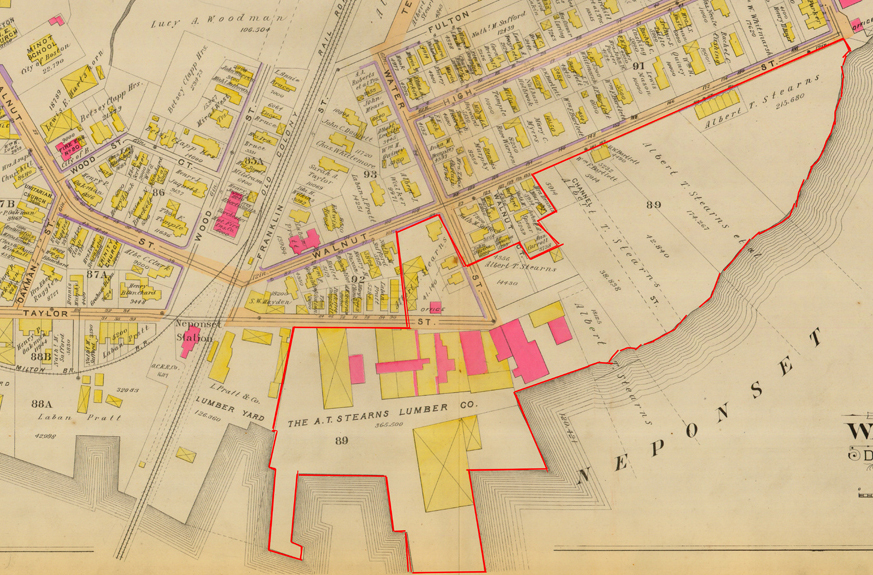
Stearns Lumber Company
Dorchester Illustration 2671
This image from the 1910 atlas, shows that the Laban Pratt’s Lumber Company extended on both sides of the train tracks at the Neponset River, but Albert Thomas Stearns Lumber Company to the east (outlined in red) dwarfed Pratt’s operations.
Stearns started in the lumber trade in 1843, in Waltham at Butrick’s lumberyard, moved from there in 1849 to Neponset. In the 1850s, two wharfs and several boat slips flanked the railroad tracks at their point of entry to Port Norfolk. According to the Taxable Evaluation of the Town of Dorchester for 1869, Taylor Street was lined with the lumber companies of Laban Pratt and Albert T. Stearns.
Pratt’s business was made up of a counting room, stable, “lumber buildings” and two wharfs. All that remains of Pratt’s lumber business are granite block bulk heads and shore retaining walls. Both Pratt and Albert T. Stearns are cited by William Dana Orcutt as being among “the several active businessmen who moved to Dorchester and did much to build up the easterly part of the town.”
There is no longer any remaining physical feature from the Stearns Company with the exception of the circa mid-19th century Greek Revival brick office structure at 98 Taylor St. This structure is labeled “office” on the 1910 atlas. The half dozen Stearns buildings that once stood across Taylor Street have all disappeared although several foundations appear to have survived amidst the underbrush.
In 1871, Stearns was sent a sample of cypress that sat unused for years before he thought to use it to make the door frames and moldings of a new office building. Afterwards, Stearns realized the potential cypress held as a finishing wood; it was inexpensive, more rot-resistant than pine, and came in a variety of rich hues.Until Stearns’ fierce advocacy of cypress, “it was the pariah of the southern swamps; it was the nemesis of the sawmill man; it was the cap-and-bells of the dealers; it was the disgust of the American consumer.”
Stearns was confident in cypress and ardently encouraged its use in projects wherever he was involved. He was so sure of its success that he regularly offered to make gutters from cypress for free, with the promise that he’d replace them with pine if they were not to his customer’s satisfaction. In a few years time, gulf cypress was an A.T. Stearns Lumber Co. speciality. The bald cypress of the southeastern United States is still available and is not considered to be threatened like other cypress trees.
On the morning of Sept. 25, 1884, a fire broke out in the engine room of the A.T. Stearns complex. The Boston Daily Globe reported, “Before 8 o’clock the place was a mass of ruins, the only buildings standing being a part of the carpenter shop, a large shed, the boiler house and office. The two latter are brick buildings, with iron shutters.” Of those two brick buildings, the “office” that survived must have been 98 Taylor St. Damage resulted in the loss of the wharf, stores of wood, and machinery that amounted to at least $200,000.
The Stearns Company rebuilt and continued business until 1968.
